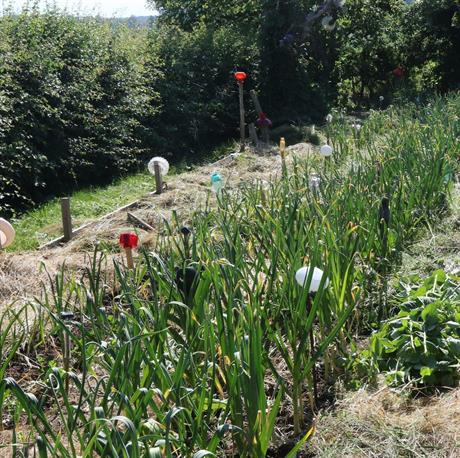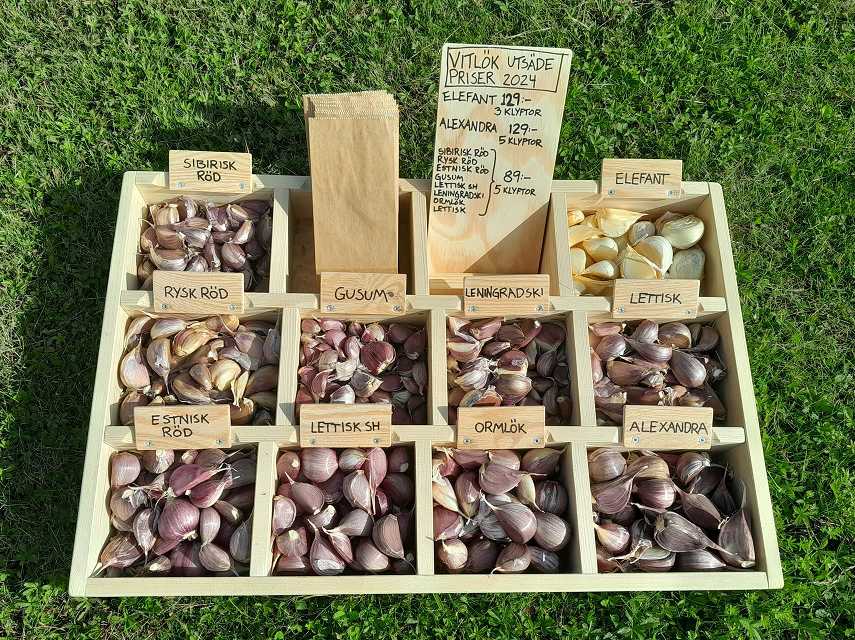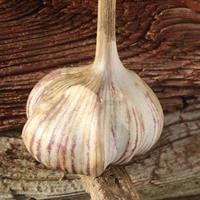Garlic for cultivation
The season for garlic is now over for this year!
We will reopen for sales again in August. Check out which variety you want to target now.

Garlic is a very good vegetable for you if you want to start growing your own. It doesn't require many square meters to become completely self-sufficient, even if you LOVE garlic!
You plant a clove in the fall and harvest a whole garlic bulb in July/August. It thrives well here in Sweden and handles drought and pests with ease. From your harvest, you break off as many cloves as you need to plant for the next year - so you'll never need to buy seeds again. Incredibly easy to sustain yourself!
Most garlic plants want to flower at the end of June - that's when these beautiful flower stalks appear. These should be broken off. Fermented garlic scapes are an amazing delicacy!
I have been selling garlic sets here in the webshop for a couple of years of one variety - but then David came and moved onto the farm bringing many more varieties. So now we are making a bigger effort for those who want to grow different kinds of garlic! Each has its own character and traits below the surface.
All the garlic we sell is grown here on the farm in our vegetable gardens where we have an 8-year crop rotation. It's not certified organic, but naturally, we grow completely without pesticides and synthetic fertilizers!

When you click on the different varieties, you are presented with the following information:
Size: medium (An assessment of the clove sizes: medium-large-very large)
Durability: medium (In spring/summer, the cloves start to yellow, lose flavor, and shrivel. We rate the storage properties as medium-good-very good)
Number of cloves: 10-11
Type: Hard neck (Hard neck refers to garlics that have a hard stem in the center after the flower stalk)
And we have our fantastic flavor reviews produced by a group of sensory experts and gourmets at the Faculty of Culinary Arts in Umeå.
Do you love raw garlic in cold sauces but dislike when it becomes too intense and overwhelming, lingering like an uninvited guest? Then Siberian Red is your new best friend. When used raw, it has a low intensity and pepperiness, but a distinctly and incredibly well-rounded garlic flavor. However, it reveals peppery and earthy notes when cooked, along with a pronounced fruitiness. Siberian Red is the ideal choice for dishes that require a subtle and rounded garlic flavor that doesn’t linger, making it excellent for use in all forms requiring raw garlic.
This year's garlic varieties

Planting
Garlic cloves should be planted in nutrient-rich soil, preferably in October, but early November works as well. About 5 cm deep and 15 cm between the plants, with 25-35 cm between rows.
However, I usually interplant garlic with celeriac and cabbage plants. Since garlic is harvested early, fall crops can then take its place!
Where the celeriac is to grow, I plant the cloves 35 cm apart and then plant celeriac plants between the garlic in May.
Where cabbage is to grow, I plant 4 cloves with 13 cm spacing and then leave a gap of 30-35 cm for a cabbage plant. It's an excellent system!
I find that garlic thrives best in mulched cultivation with partially raised beds and fixed rows. I place mesh over them just after planting so that the chickens don’t dig them up...
Remove the buds – and turn them into a luxurious delicacy!
When garlic begins to bloom at the end of June (as seen in the picture), the buds should be removed. This is important because otherwise much of the energy will go into the flower. If you break off these buds with as much stem as possible, all the way until it starts to become woody and fibrous, you can ferment these garlic buds. They become an incredibly delicious delicacy. Coarsely chop them, weigh them, add approximately 1.1 - 1.5% salt, and massage it in. Let it sit for about half a day, then press them into regular glass jars and put on the lids. You can add a bit of water, but it's not entirely necessary for the liquid to reach the top. You can also layer in other young vegetables like carrots and small yellow onions. Let it sit at room temperature for at least a month and then store in the fridge. Fermented garlic buds are apparently a Korean delicacy, but they are equally delicious in Sweden! Pure umami, indeed.
Harvest
The garlic itself is harvested a couple of weeks later – here, where I am in Östergötland, around July 10-20. You usually harvest them when the two lowest substantial leaves have withered. You pull up the entire plant, check one more time to make sure it doesn’t have a bulb (which must be removed). Then you place them to dry in a sunny spot. After a month or a maximum of two, you cut off the stem (unless you want to make braids, of course...) and brush off some soil.
Winter storage
Bring them to room temperature as soon as they have dried. They should be stored in a warm and airy place. It's important to trick them into believing that winter has never come, because if they have been exposed to cold, they start to sprout much more easily indoors early in the spring.
Save cloves for cultivation
In October, plant new cloves - as many as you want this time! Soon you'll have your own large garlic farm. They're like potatoes; once you start growing them, it's so incredibly easy to just keep going!
Good luck with your garlic cultivation!










